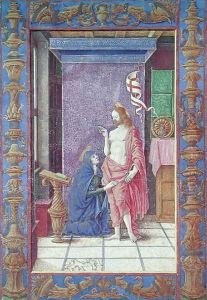dai Libri Girolamo Paintings
Girolamo dai Libri was an Italian painter of the Renaissance period, born in 1474 in Verona, Italy, into a family that was well known in the artistic community. His father was Vincenzo di Francesco, a painter and manuscript illuminator, from whom Girolamo inherited his artistic talents and interest in the arts. The surname 'dai Libri' literally means 'from the books', reflecting the family's association with book illumination and manuscript decoration, which were highly regarded skills during the Renaissance.
Girolamo received his early training in the art of illumination from his father, which laid the foundation for his meticulous attention to detail and his vibrant use of color, characteristics that would later define his larger works on canvas and fresco. As he matured as an artist, Girolamo began to move beyond book illumination, applying his skills to altarpieces and frescoes, thereby contributing significantly to the artistic landscape of Verona and the surrounding regions.
Throughout his career, Girolamo dai Libri was celebrated for his religious compositions, which combined a delicate grace with a profound sense of piety. His works often featured intricate landscapes, detailed botanical illustrations, and expressive figures, all of which demonstrated his mastery over both composition and color. Among his most famous works are the 'Madonna and Child with Saints' in the church of Santa Maria in Organo in Verona, and the 'Madonna of the Oak Tree', which showcases his ability to blend religious iconography with natural elements to create serene, harmonious compositions.
Girolamo's contributions to the art world extended beyond his individual creations. He was a central figure in the Veronese school of painting, influencing a generation of artists with his techniques and stylistic choices. His legacy is seen in the way he combined the traditional elements of Gothic art with the emerging principles of the Renaissance, bridging two significant periods in art history.
Girolamo dai Libri died in 1555 in Verona, leaving behind a body of work that continues to be admired for its beauty and its historical significance. His paintings are preserved in various museums and churches, serving as testaments to the skill and spirituality of this Renaissance master.
